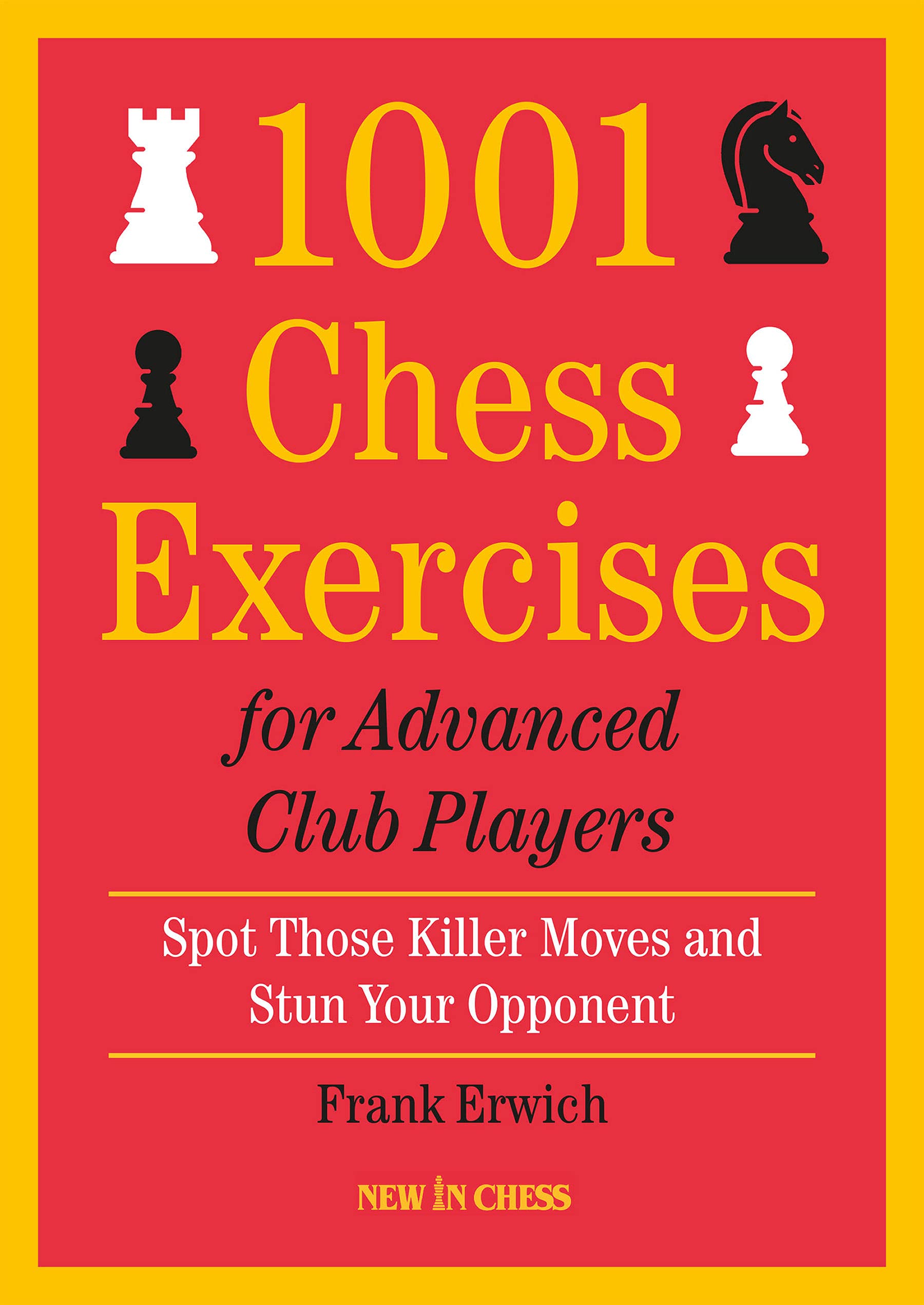1001 Chess Exercises for Advanced Club Players : Frank Erwich

“Tactics is knowing what to do when there is something to do; strategy is knowing what to do when there is nothing to do.” – Savielly Tartakower
From the publishers blurb:
“In this follow-up to his acclaimed 1001 Chess Exercise for Club Players, FIDE Master Frank Erwich teaches you how to reach the next level of identifying weak spots in the position of your opponent, recognizing patterns of combinations, visualizing tricks and calculating effectively.
Erwich repeats the themes of his previous book, focusing on exercises in which the key move is less obvious. He also introduces new, more sophisticated tactical weapons. They are geared towards the reality of the advanced club player (Elo 1800 2300): it is not enough to spot simple combinations, at this level you must be able to resist your reflexes and look deeper. In variations that look forcing you will always search for that deadly Zwischenzug. Quiet moves in general should be your new best friends.
In short: an advanced club player should expect the unexpected. One of the celebrated elements of Erwichs previous book, which is neglected in other books on tactics, is back: defence! You will also learn how to defend against tactics, as well as how to use tactical weapons when you are under heavy pressure. This is a complete and structured course, and not just a collection of freewheeling puzzles. Erwich starts every chapter with an instructive explanation of the tactical concept at hand and has carefully selected the most didactically productive exercises.
FIDE Master Frank Erwich is a a professional chess teacher for the Royal Dutch Chess Federations, coach and active player. In 2012 he established a teaching company and, from his own web site
He holds a Masters degree in Psychology.
He works as an editor for New in Chess, he helps with the development of material for chess books and chess apps, he writes about chess (including author of 1001 Chess Exercises for Club Players and the e-book Basic Chess rules for Kids ), he makes online lessons for starting chess players and he is regularly active as a coach during a chess tournament (including during the European Youth Championship in 2014, 2015 and 2016).

Tactics books are, of course, part of the staple publishing diet of many chess specialists. What is the USP of this one?
Erwich has collected 1001 (no, this is nothing to do with carpet cleaning*) positions from recent tournament praxis the majority of which (just like the preceding volume) are from the last ten years.
They have been organised into ten groupings viz :
- Main Tactics
- In-between moves
- Automatic moves
- Surprises and traps
- Diagonals, ranks and files
- The walking King
- Manoeuvres
- Special threats and quiet moves
- Calculation and move order
- Defence
which are followed by a chapter entitled “Mix” which combines many of the previous themes and of course, a Solutions to each exercise chapter.
As with every recent New in Chess publication high quality paper is used and the printing is clear. The book can easily be laid flat next to the board and does not require weights to prevent it from “self-closing” (a particular bugbear of mine !). More or less each diagram clearly shows who is to move but for a curious reason the diagrams showing analysis are left without one. I’ve no idea of the reasoning for this decision.
The instructional text is typeset in two column format, which, I find, enables the reader to maintain their place easily. Figurine algebraic notation is used throughout and the diagrams are placed adjacent to the relevant text.
You might have noticed that in the list of categories the author has inserted “Trapping a piece” and “Defending” which are welcome (not often discussed) themes among the more familiar ones.
Each chapter kicks-off with a description of the theme in question followed by high quality examples. All jargon and terms are explained in detail making each section self-contained eliminating the need to go elsewhere to cross-reference. Sometimes the author invents his own terminology (such as “away” and “chasing”) in cases where there is a need and all is carefully explained.
Following the instructional text and examples there are, on average 100 test positions given as groups of twelve per page. Each diagram clearly indicates who is to move and underneath most is a hint such as “King hunt: series of checks”. I prefer to hide the hint but some will value these clues. Of course, after say a dozen in one section, one gets a feel for what is expected and this forms part of the training. Each solution provides useful analysis (which has been engine checked) plus contextual information about the source game, players and event.
To give you some idea of the content here are some samples:
A fairly straightforward but pleasing example (#102) from “In-between moves”:
and from “Automatic moves” we have #193 which is rather lovely but not difficult:
and this pleasing example (#325) from “Surprises and traps”
Finally, as before, a detailed glossary in itself provides learning opportunities to improve one’s knowledge.
Once again It was a pleasure to work through some of the exercises and I’m confident the book will provide ideas for my student lessons and coaching.
The most enjoyable section (one again, as before) was Chapter 11 entitled “Mix”. This is the best test of what has gone before since there is no declared theme, and, more often than not, no visible hint. You are on your own and you might start a chess timer with each new position to provide motivation and test your speed and accuracy of solution.
In summary this is an excellent follow-up book that goes highly recommended. If I hadn’t had it to review then I would have purchased it anyway! Most excellent and deserving of the accolades and a great stocking filler.
John Upham, Cove, Hampshire, December 10th 2021

Book Details :
- Hardcover : 216 pages
- Publisher: New In chess (31 December 2021)
- Language: English
- ISBN-10: 9056919709
- ISBN-13: 978-9056919702
- Product Dimensions: 16.9 x 1.2 x 24 cm
Official web site of New in Chess

(*Probably only amusing for our UK based readers).
